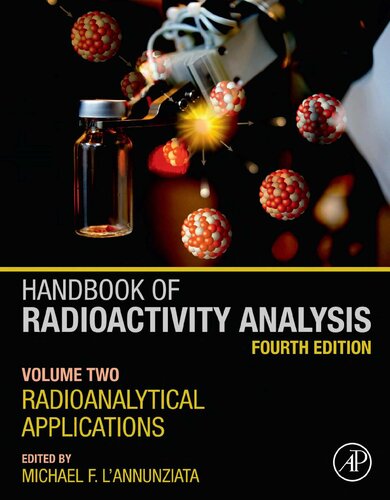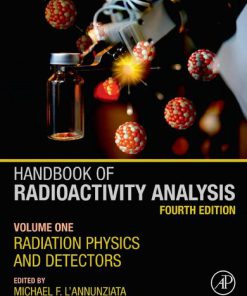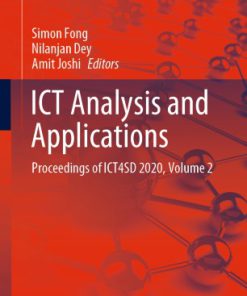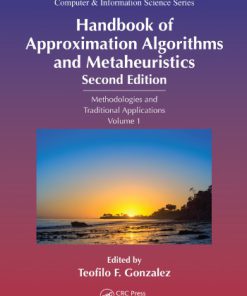Handbook of Radioactivity Analysis Volume 2 Radioanalytical Applications 4th Edition by Michael F L Annunziata ISBN 0128143959 9780128143957
$50.00 Original price was: $50.00.$25.00Current price is: $25.00.
Handbook of Radioactivity Analysis Volume 2 Radioanalytical Applications 4th Edition by Michael F L Annunziata – Ebook PDF Instant Download/Delivery: 0128143959, 9780128143957
Full download Handbook of Radioactivity Analysis Volume 2 Radioanalytical Applications 4th Edition after payment

Product details:
ISBN 10: 0128143959
ISBN 13: 9780128143957
Author: Michael F L Annunziata
Handbook of Radioactivity Analysis: Radiation Physics and Detectors, Volume One, and Radioanalytical Applications, Volume Two, Fourth Edition, constitute an authoritative reference on the principles, practical techniques and procedures for the accurate measurement of radioactivity – everything from the very low levels encountered in the environment, to higher levels measured in radioisotope research, clinical laboratories, biological sciences, radionuclide standardization, nuclear medicine, nuclear power, and fuel cycle facilities, and in the implementation of nuclear forensic analysis and nuclear safeguards. It includes sample preparation techniques for all types of matrices found in the environment, including soil, water, air, plant matter and animal tissue, and surface swipes.
Users will find the latest advances in the applications of radioactivity analysis across various fields, including environmental monitoring, radiochemical standardization, high-resolution beta imaging, automated radiochemical separation, nuclear forensics, and more.
- Spans two volumes, Radiation Physics and Detectors and Radioanalytical Applications
- Includes a new chapter on the analysis of environmental radionuclides
- Provides the latest advances in the applications of liquid and solid scintillation analysis, alpha- and gamma spectrometry, mass spectrometric analysis, Cherenkov counting, flow-cell radionuclide analysis, radionuclide standardization, aerosol analysis, high-resolution beta imaging techniques, analytical techniques in nuclear forensics, and nuclear safeguards
- Describes the timesaving techniques of computer-controlled automatic separation and activity analysis of radionuclides
- Provides an extensive table of the radiation characteristics of most radionuclides of interest for the radioanalytical chemist
Handbook of Radioactivity Analysis Volume 2 Radioanalytical Applications 4th Table of contents:
Chapter 1. Environmental radioactivity monitoring
I. Introduction: objective of environmental monitoring
II. Types of monitoring programs
III. Fundamentals of environmental monitoring
IV. Monitoring for internal exposure
V. Monitoring for external exposure
VI. Mobile monitoring
Chapter 2. Environmental liquid scintillation analysis
I. Introduction
II. Low-level liquid scintillation counting theory
III. Alpha/beta discrimination
IV. Triple-to-double coincidence ratio (TDCR) counting
V. Analysis of alpha-emitting transuranic nuclides
VI. Analysis of beta-emitting radionuclides
VII. Analysis of radionuclides from natural decay series
VIII. Spectrum deconvolution methods in environmental analysis
Chapter 3. Analysis of environmental radionuclides
I. Introduction
II. Environmental radionuclides
III. Radionuclide compartments
IV. Analytical techniques
V. Radionuclide analyses
VI. International networks for monitoring of environmental radionuclides
VII. Conclusions
Chapter 4. Radioactive aerosol analysis
I. Introduction
II. Radioactive aerosol sampling and measurement
III. Radioactive aerosols in ambient air
IV. Residence time of radioactive aerosols
Chapter 5. Marine radioactivity analysis
I. Introduction
II. Sampling techniques
III. Underwater gamma-ray spectrometry
IV. Analysis of natural radionuclides
V. Analysis of anthropogenic radionuclides
VI. Activity measurement techniques
VII. Analysis of radioactive particles
VIII. Management of data quality
IX. Marine radioactivity databases
X. Examples of marine radioactivity studies
XI. Conclusions
Chapter 6. Cherenkov counting
I. Introduction
II. Discovery of Cherenkov radiation
III. Theory and properties of Cherenkov radiation
IV. Quenching and quench correction
V. Cherenkov counting parameters
VI. Cherenkov counting in the dry state
VII. Radionuclide analysis with silica aerogels
VIII. Cherenkov counting in microplate format
IX. Multiple radionuclide analysis
X. Radionuclide standardization
XI. Gamma ray detection and discrimination
XII. Particle identification
XIII. Neutrino detection and measurement
XIV. Applications in radionuclide analysis
XV. Advantages and disadvantages in radionuclide analysis
XVI. Recommendations in radionuclide analysis
Chapter 7. Radionuclide standardization
I. Introduction
II. Absolute direct methods
III. Solid angle primary methods
IV. Relative methods
V. Reference systems
VI. Preparation of radioactive samples
Chapter 8. Radioactivity counting statistics
I. Introduction
II. Statistical distributions
III. Analysis of a sample of results
IV. Statistical inference
V. Regression
VI. Detection limits
VII. Metrology applications
Chapter 9. High-resolution beta imaging
I. Introduction
II. Autoradiography principles
III. Energy-storage latent imaging
IV. Particle counting imaging systems
V. Comparative use of the different techniques
VI. Other applications
VII. Perspectives and future developments
VIII. Conclusions
Chapter 10. Flow-cell radionuclide analysis
I. Introduction
II. High-performance liquid chromatography flow-cell analyzers
III. Principles of flow scintillation counting
IV. Flow scintillator selection
V. Dual-functionality flow-cell detectors
VI. Flow-cell radionuclide analysis sequential to separation
VII. Stopped-flow detection
VIII. Flow-cell effluent water monitors
IX. Single radionuclide analysis in high-performance liquid chromatography
X. Dual radionuclide analysis
XI. Online HPLC-FSA and mass spectrometry
XII. Online FSA and nuclear magnetic resonance
XIII. Online HPLC-FSA-MS-NMR
Chapter 11. Automated radiochemical separation, analysis, and sensing
I. Introduction
II. Radiochemical separations
III. Automation of radiochemical analysis using flow injection or sequential injection fluidics
IV. Selected radiochemical analysis examples
V. Automation using robotics
VI. Automated monitors for industrial scale nuclear processes
VII. Radionuclide sensors and systems for water monitoring
VIII. Digital microfluidics for microscale single bead manipulations
IX. Radioisotopes in medicine
X. Discussion
Chapter 12. Analytical techniques in nuclear safeguards
I. Introduction
II. Photon-based assay for safeguards
III. Neutron-based assay for safeguards
IV. Calorimetric assay
Chapter 13. Nuclear forensics
I. Introduction
II. The origins of nuclear forensics
III. National objectives
IV. Nuclear attribution
V. Nuclear forensic interpretation
VI. Validated signatures
VII. Analytical results
VIII. Validated methods
IX. Quality assurance
X. Sampling
XI. Conclusions
People also search for Handbook of Radioactivity Analysis Volume 2 Radioanalytical Applications 4th:
handbook of radioactivity analysis
handbook of radioactivity analysis pdf
handbook of radioactivity analysis volume 1
handbook of radioactivity analysis volume 2
handbook of radioactivity analysis pdf free download
Tags:
Michael F L Annunziata,Radioactivity Analysis,Radioanalytical Applications
You may also like…
Physics - Nuclear
Engineering
Handbook of natural fibres Volume 2 Processing and applications Second Edition Kozłowski
Politics & Philosophy - Social Sciences
Science (General)











